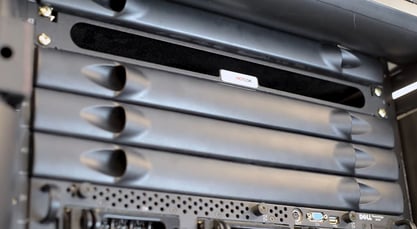Every data center industry standard and best practice compilation specifies the importance of having all rack-mounted equipment breathe from front to rear. The minor exception is the telco standard, which merely recommends that all equipment receive and move air in the same direction. Not only is the exclusive use of front-to-rear breathing equipment important, but a reasonable case can be made that deploying such equipment is the single most important airflow management practice for a healthy data center. After all, consider for a moment the relationship between the air movement direction of IT equipment and the other tactics, strategies, and disciplines that comprise the basic principles and practices of standards, best practice guidelines, white papers, textbooks, and countless conference presentations and certification curricula:
Blanking panels without exclusive front-to-rear breathing equipment could prevent bypass air from entering the rear of the cabinet or the sides of the cabinet to mix with exhaust air, thereby prevent in the creation of an environment more conducive to the survival of non-compliant airflow equipment ingesting from those hot areas.
Cable access cut-out floor grommets without exclusive front-to-rear breathing equipment could prevent bypass air from entering the rear of the cabinet or the sides of the cabinet to mix with exhaust air and likewise prevent the creation of a hot and cold mixture of air for equipment pulling air in from the sides or rears of cabinets.
Hot aisle – cold aisle separation, by definition, would not exist without exclusive front-to-rear breathing equipment.
Controlling supply temperatures by feedback from the equipment air in-take points would not be practical with 15-20˚F differences in input temperatures, depending on the airflow protocol direction and volume of bypass.
Changing from a return thermostat temperature control to a supply control temperature will not be effective when some equipment will be ingesting input air mostly from the return side of the data center row layout.
Reducing fan speeds may not be practical when some amount of bypass air needs to be produced to drop the temperature in the “hot” aisle to support non-standard breathing equipment.
Raising supply air temperatures may be disastrous when some equipment may be ingesting air that is input temperature plus equipment temperature rise (ΔT), or even exhaust temperature plus ΔT.
 In addition to installing design-intent non-compliant airflow equipment, we have exacerbated the situation by willfully and intentionally installing some switch equipment backward, particularly in top-of-rack switch deployments. However, this strange behavior does not make us criminals – it merely makes us sensitive to the demands of accessing switch ports for connecting our networks. Fortunately, the switch manufacturers have been paying attention to our dilemma, and many switches are now available with buyer-specifiable front-to-rear or rear-to-front internal fan trays. Nevertheless, while these sophisticated design options make our work easier, we still have details that need attending to in order to fully realize the benefits of the new switches with fan direction options. An Upsite Technologies® customer has graciously shared data from two different data centers to provide real-world examples of the benefits of incorporating one of their SwitchFix accessories with corrected fan direction switches.
In addition to installing design-intent non-compliant airflow equipment, we have exacerbated the situation by willfully and intentionally installing some switch equipment backward, particularly in top-of-rack switch deployments. However, this strange behavior does not make us criminals – it merely makes us sensitive to the demands of accessing switch ports for connecting our networks. Fortunately, the switch manufacturers have been paying attention to our dilemma, and many switches are now available with buyer-specifiable front-to-rear or rear-to-front internal fan trays. Nevertheless, while these sophisticated design options make our work easier, we still have details that need attending to in order to fully realize the benefits of the new switches with fan direction options. An Upsite Technologies® customer has graciously shared data from two different data centers to provide real-world examples of the benefits of incorporating one of their SwitchFix accessories with corrected fan direction switches.


.png?width=58&height=58&name=X_logo_2023_(white).png)
